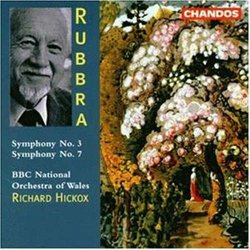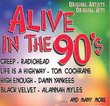| All Artists: Edmund Rubbra, Richard Hickox, BBC National Orchestra of Wales Title: Rubbra: Symphonies No. 3 & 7 Members Wishing: 0 Total Copies: 0 Label: Chandos Release Date: 7/21/1998 Genre: Classical Styles: Historical Periods, Modern, 20th, & 21st Century, Symphonies Number of Discs: 1 SwapaCD Credits: 1 UPC: 095115963425 |
Search - Edmund Rubbra, Richard Hickox, BBC National Orchestra of Wales :: Rubbra: Symphonies No. 3 & 7
 | Edmund Rubbra, Richard Hickox, BBC National Orchestra of Wales Rubbra: Symphonies No. 3 & 7 Genre: Classical
|
Larger Image |
CD DetailsSimilar CDs
|
CD ReviewsThe beginning and end of the middle period Rodney Gavin Bullock | Winchester, Hampshire Angleterre | 05/13/2001 (5 out of 5 stars) "After the grimness of the 1st and the stern contrapuntal workings of the 2nd, the innate lyricism that lies at the centre of Rubbra's music came out in the guise of the 3rd. This is a delightful symphony. The orchestration is more transparent. This change had taken place over 3-4 years - he must have been writing at a tremendous pace. The first movement starts in a rather understated fashion but builds up in a most inventive way, waxing and waning. It all seems so inevitable. No one else writes like this. A dance-like movement follows, recalling the 1st symphony. The slow movement is grave and beautiful. The only musicologist to write a full-length study on Rubbra is the American, Ralph Scott Grover. He says, '[It]is not one of Rubbra's most memorable slow movements'. I could not disagree more. It is too short, perhaps. The finale is called 'Tema con 7 variazioni e una fuga'. This, I feel, is the weakest part of the symphony. The variations are separated from each other by gaps and so the music does not flow. However, the final fugue brings things to a nice conclusion. The 7th symphony was Rubbra's last for a long time and one wonders if he felt he had reached a dead end though from the quality of the music, I wonder why. It begins with solemn horn calls and the atmosphere is intially very like that of the start of the 11th. The music is noble and there is a sad beauty about it. As the movement unfolds, you again feel it is all so inevitable, though you cannot predict it. The scherzo is one of Rubbra's happiest inspirations. Harp, tambourines, side drum, xylophone and celesta add touches of colour to this beautifully scored music. It is a kind of rondo, with the rhythmic beginning section alternating with other episodes. Towards the end, after all this fun, there is a soft tam-tam note and a gorgeous melody breaks out on the strings, a tune to bring you out in goose bumps. The rhythmic music reappears bringing it all to a riotous end. Simply marvellous stuff. The passacaglia and fugue begins, not surprisingly with the solemn passacaglia theme on the low strings. This is weighty stuff and no mistake. Towards the end, the clarinet starts off the fugue, the elegiac mood becomes more optimistic and the symphony ends quietly. The performance is first rate, as is the recording and presentation." Rubbra's Renaissance Imagination Thomas F. Bertonneau | Oswego, NY United States | 12/11/2000 (4 out of 5 stars) "It belongs to Edmund Rubbra's (1901-1986) integrity that he never wrote music topical, or pictorial, or overtly dramatic that might exert some extrinsic appeal on audiences looking for the superficially arresting. He sought only express his deep and abiding faith, the musical emblem of which he found in the forms of the Renaissance and the Baroque, his use of which tells us that he found them timelessly true in a truly Platonic, or Augustinian, sense. Yet Rubbra by no means fits under the label of "neo-classicism." On the contrary, in addition to his trust in Palestrinian and Bachian counterpoint, he took up with sincerity something of the Wordsworthian - the Romantic - creed: A passion for the spiritual content of landscape, a delight in the spontaneous growth of living organisms, a conviction that in desire lies a clue that the individual partakes in something invisible that transcends and completes him. In the "neo-classical" ethos, the eighteenth century musical forms undergo a revival, but ironically, and the composer employs them only to make brief pastiches of Bach or Haydn. Hence Stravinky's numerous faux Brandenburg concerti, or Hindemith's vaudevillian "Kammermusiks." Primarily a symphonist, Rubbra by contrast worked on a fairly large scale; and no grand jury in creation would ever dream of indicting him for irony. Not to mean what one says would have struck Rubbra as a sin, which, given the duplicity of human affairs in the twentieth century, maybe it is. The preternaturally calm Third (1939) and Fourth (1941) Symphonies belong to the war years, which pressing fact their serenity belies not in the slightest; Rubbra responded to the war by invoking the most serene faith. In Richard Hickox's cycle for Chandos, the Third comes coupled with the Seventh (1957). Rubbra's critics have noted that the Third exhibits less contrapuntal crowding in its textures than the First or the Second. The First Movement (Moderato) of the Third sounds to me, however, as complex as that of the Second, the difference perhaps being the distinctness of the material, and the unity supplied by the almost continuous pizzicato bass. Sibelius is a presence, especially in Rubbra's writing for the woodwinds. The instrumental choirs - strings, brass, and reeds - remain separate: Perhaps this accounts, in part, for the critics' contention of translucency. The Second Movement (Allegro) substitutes for the usual scherzo. Rubbra's scherzo (or scherzo-substitute) movements tend to introduce naive material which the composer then subjects to swift elaboration, often creating a sense of menace through the piling up of unresolved chords of the seventh, generated coincidentally out of the polyphonic convergence of lines. The "Périgourdine" of the First Symphony sets out the pattern. As in the Second, the heart of the Third lies in the slow movement (Molto Adagio Ma Liberamente), a minor-key threnody over another one of those relentless bass-figures that appear with regularity in Rubbra's symphonies, and that links the Third's Adagio to its Allegro. The Finale comprises a "Theme and [Seven] Variations with a Fugue." The theme wears a slightly Elgarian countenance. The fugue resolves many of the conflicts of the symphony as a whole. The Seventh Symphony in C-Major arranges itself in three movements, the first of which (Lento Molto Ed Espressivo) grows from the plain intervals of the triadic chord - in Rubbra's usual contrapuntal fashion. The central Scherzo (Vivace e Leggiero) looks back to the music of Rubbra's mentor, Gustav Holst; the Trio features the celesta. Variation-forms assume prominence in Rubbra's idea of development: The Finale (Lento) of the Seventh consists of a Passacaglia and Fugue, a stricter rethinking, in its way, of the Variations and Fugue of the Third Symphony. The Seventh once appeared, under Sir Adrian Boult, on Lyrita (both LP and CD). It's a shame that Boult's performance has dropped from circulation, but Hickox's is fine and should be snapped up by anyone keen on the byways of English symphonism in the middle of the twentieth century." Soul Music Thomas F. Bertonneau | 10/01/2000 (5 out of 5 stars) "Although his fourth symphony is generally accepted as Rubbra's masterpiece, the third and seventh symphonies are also strong contenders. Rubbra's music is civilised, well-crafted and imbued with a mysticism that is medieval in spirit. Rubbra's music is rich in invention and with each new listening, another layer is revealed. There are few pieces of music that I have returned to as many times as the third and seventh symphonies. Rubbra's music is very intimate and not at all 'showy', which is perhaps it has failed to gain a foothold in the concert hall. In this increasingly materialistic age, Rubbra's music is a much-needed breath of fresh air. If you want to recharge your spiritual batteries and engage your intellect at the same time, try this wonderful recording."
|

 Track Listings (7) - Disc #1
Track Listings (7) - Disc #1

